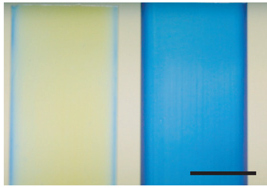Team:Cambridge/Future/Visuals
From 2011.igem.org
(Created page with "{{Template:Team:Cambridge/CAM_2011_TEMPLATE_HEAD}} As this project is based around colour and light interactions, our characterisation experiments are set up to provide visual r...")
Newer edit →
Revision as of 13:12, 16 August 2011
As this project is based around colour and light interactions, our characterisation experiments are set up to provide visual results in every facet of the project.
In vivo imaging
In vitro photonic devices
Previous work on reflectin proteins has used purified protein in solution to coat wafers of silicon. This creates the beautiful coloured images seen below. We can alter the final colour depending on the thickness of the layer or the concentration of the protein solution.
As part of our collaboration with nanophotonics, we have a number of techniques we plan to use in order to create different optical structures. For example, we aim make diffraction gratings, which will reflect light from across the spectrum (rather than the narrow range reflected by thin films). Reflectin appears to spontaneously form diffraction gratings on exposure to different solvents. We will also try layering reflectin with another polymer, to create a stacked structure which will give more intense colour due to additive effect of interference patterns.
To build upon the work that has been done by researchers investigating reflectin, we hope to prove the feasibility of using these proteins as the next generation of flexible optical devices. Reflectin in cephalopods can give a range of colours based on dynamically changing the spacing of the protein assemblies, due to the charge differences caused by addition of phosphates. We hope to build a prototype of a non-backlit screen which reflects incident light of different colours.
Previous iGEM projects
As our project is a natural extension of previous Cambridge teams' efforts with light and pigment-based colour, we would be happy to show some of their finished projects alongside our own work.
 "
"

